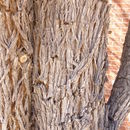en
names in breadcrumbs


Bolusanthus speciosus (tree wisteria) is a species of flowering plants in the family Fabaceae. It belongs to the subfamily Faboideae. It is the only member of the genus Bolusanthus .[1][2][3]
It is a small deciduous tree, which can grow up to 7 m (23 ft) tall. It has black, fissured rough bark and also drooping branches. Between September and October, when the tree has no leaves it begins to bloom, with lilac blue flowers. Later it produces a seed capsule, the grey pods contain 3-8 smooth, bright yellow or brown seeds.[4]
The wood is very hard, heavy and yellow in colour. It can be used for axe-handles, wagon spokes and fencing poles. The tree is also grown in gardens due to the attractive flowers.[4]
It is native to KwaZulu-Natal and Northern Provinces (of South Africa), Eswatini, Botswana, Malawi, Mozambique, Zambia and Zimbabwe.[5] It is found in low - medium altitudes in woodland or wooded grasslands.[4]
The genus name of Bolusanthus is in honour of Harry Bolus, (1834 – 1911) who was a South African botanist, botanical artist, businessman and philanthropist,[6] and 'anthus' the Greek word for flower.
It was first published and described by (Bolus) Hermann Harms (a German botanist) in Repert. Spec. Nov. Regni Veg. 2: 15 in 1906.[5]
Bolusanthus speciosus (tree wisteria) is a species of flowering plants in the family Fabaceae. It belongs to the subfamily Faboideae. It is the only member of the genus Bolusanthus .